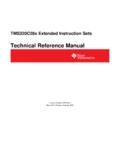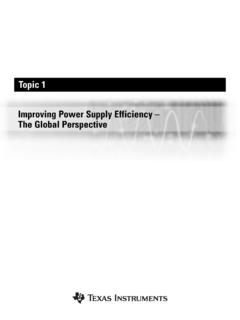Transcription of TRANS AFRICA PIPELINE (TAP)
1 Copyright Property of TRANS - AFRICA PIPELINE Inc. 1 TRANS AFRICA PIPELINE : Sustainable Water for Sub Sahara AFRICA Rod Tennyson, PhD, PEng Professor Emeritus, University of Toronto Institute for Aerospace Studies 614-99 Harbour Sq., Toronto, Ontario, Canada, M5J2H2 ABSTRACT This paper provides an overview of the technical and economic feasibility for constructing a TRANS AFRICA PIPELINE (TAP) across the sub-Saharan region of AFRICA for the delivery of fresh clean water. To provide a sustainable supply of fresh water from unlimited ocean resources, desalination technology can deliver the necessary quantity of clean water and allow fertile farm oases to be created adjacent to TAP.
2 As the population s health improves, and the number of farm oases increases, export of food products will reduce poverty. Desalination is the only source of sustainable fresh water available for the sub-Sahara countries if this water crisis is to be solved. Based on population statistics for the countries in the sub-Sahara region, the number of people who will directly benefit from TAP is estimated to be over 20 million. Keywords: water supply and delivery, desalination, pipelines, storage tanks, AFRICA NOMENCLATURE B billion (109) d day gal US gallons h hours k kilo (103) kW kilowatts kWh/d kilowatt hours per day l liters l/p/d liters per person per day mg milligram M million (106) m meter MW megawatts SCADA supervisory control and data acquisition software tds total dissolved solids USD US dollars yr year Copyright Property of TRANS - AFRICA PIPELINE Inc.
3 2 INTRODUCTION Water is the single most important factor that will ensure the survival of millions of Africans scattered across the many countries adjacent to the encroaching desertification of AFRICA . The objective of this paper is to demonstrate the feasibility of building a water PIPELINE across the sub-Sahara region of AFRICA to begin to alleviate human dehydration, reduce diseases caused by infected water and poor sanitation, eliminate agricultural drought, and begin the transformation of this region back to a self-sustaining existence.
4 Recent United Nations studies state that over 2 billion people will suffer severe water shortages by 2050. In the next 10 years, all of the countries predicted to be water scarce are in AFRICA in the sub-Sahara region. The expected doubling of this area s population in the next 40 years will exacerbate this problem. Regional conflicts over water supplies are also predicted to increase in this time frame, particularly in those countries that have access to rivers flowing across their boundaries.
5 However, the sub-Saharan countries have no access to sustainable water supplies. It is well documented that most of these countries, numbering about 14 in total, are the driest regions in AFRICA , frequently suffering severe drought conditions year after year. A sustainable supply of fresh water from unlimited ocean resources using current desalination technology can alleviate annual drought and death tolls, and provide for the creation of local farm oases along the TAP route. As the population s health improves, and the number of farm oases increases, export of food products will reduce poverty.
6 Desalination is the only source of sustainable fresh water available for the sub-Sahara countries if this water crisis is to be solved. THE TAP CONCEPT The TAP concept is envisaged as an east-west PIPELINE , approximately 6000 km long, originating from coastal nuclear powered desalination plants. Desalination plants will be built at each ocean terminus to provide security of supply, and redundancy when Copyright Property of TRANS - AFRICA PIPELINE Inc. 3 plant downtimes are required for repair and maintenance.
7 Water will flow in both directions simultaneously to fill massive water storage tank farms strategically located along the path of TAP to service local populations. TAP consists of a primary Grand Trunk PIPELINE (GTP) connected to the desalination plants, with north-south distribution pipelines branching off the GTP to supply distributed tank farms to service local population centres. Pumping stations will be located as required along the TAP route to maintain water flow rates and supply the storage tank farms.
8 Solar energy combined with wind power are the energy sources of choice where no access to electrical power off a grid is available. The nuclear powered desalination plants will be located in areas adjacent to ocean harbours or bays. The pump stations will also serve as monitoring sites employing PIPELINE sensor systems for detection of pipe leaks, third party intrusion and system integrity. Using standard SCADA systems, the data will be relayed via satellite to central monitoring stations located in each country that will be responsible for TAP security and maintenance.
9 HUMAN WATER REQUIREMENTS The major purpose of TAP is to provide potable water for the populations of the sub-Saharan countries. The basic human survival requirement for drinking water in a hot climate is about 3 to 5 litres/day. Taking into account additional human needs for sanitation, bathing and cooking, this figure grows to about 30 to 50 litres/person/day (l/p/d). (Gleick,1996). Applying this criterion for a population of 20 M people yields a minimum required production capacity of 600 million litres/day.
10 This corresponds to 600,000 m3 per day production from desalination plants, which is equivalent to about 160M US gal/day (1m3 = 260 US gal; throughout the paper, all gallons are US). CREATING FARMING OASES BY IRRIGATION Although there are irrigated regions located in many of these sub-Sahara countries, they are insufficient to alleviate the massive droughts that plague most of Copyright Property of TRANS - AFRICA PIPELINE Inc. 4 these regions and devastate their populations.






